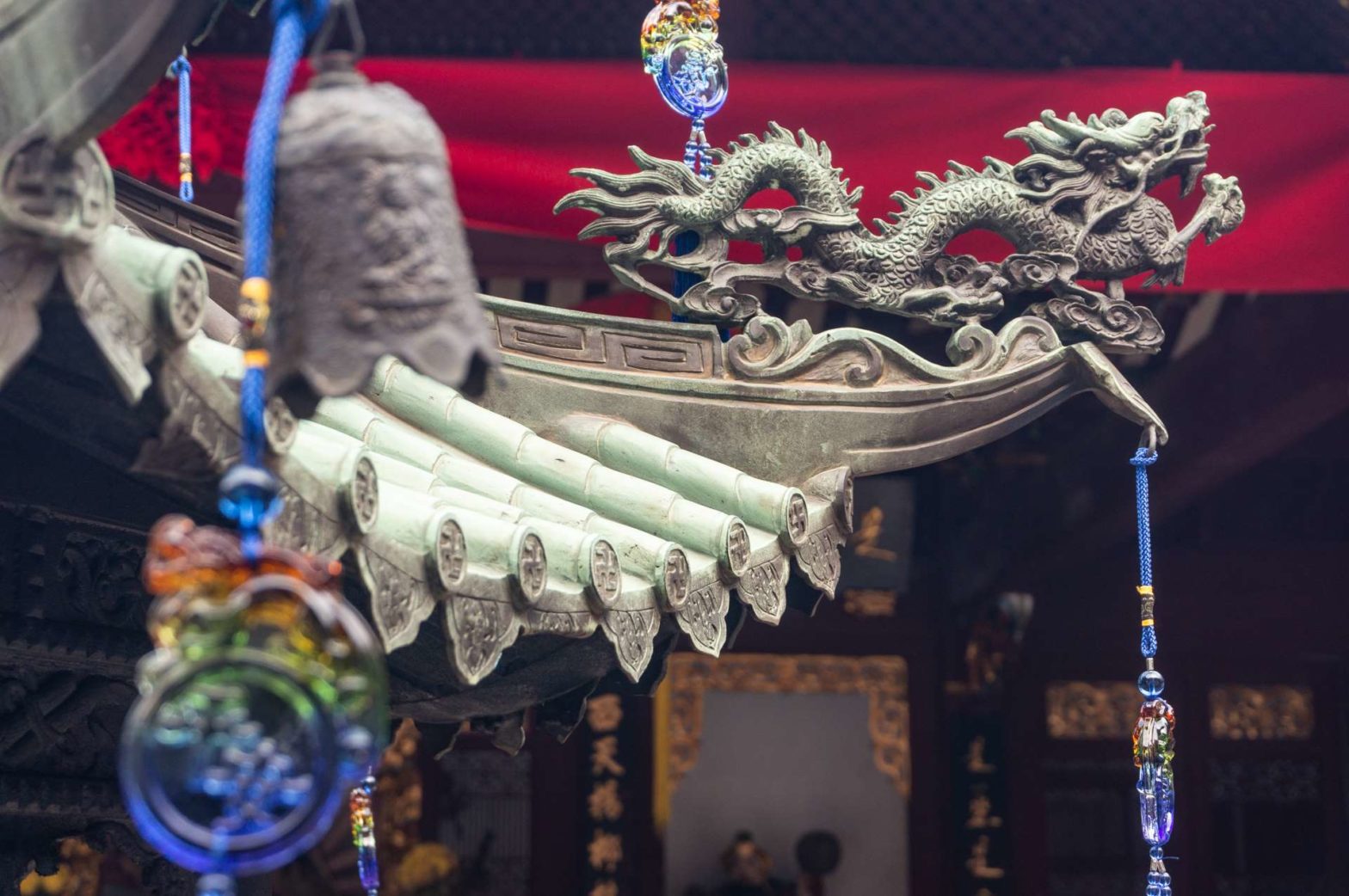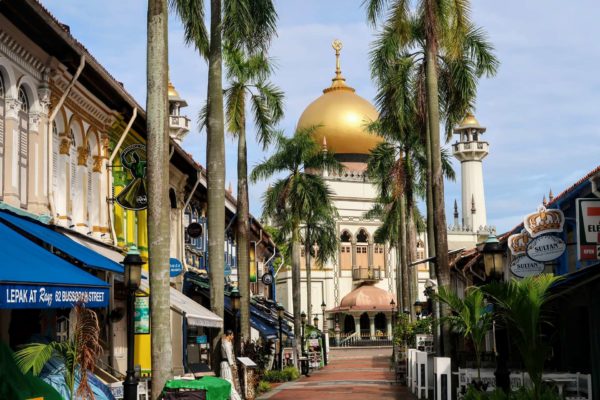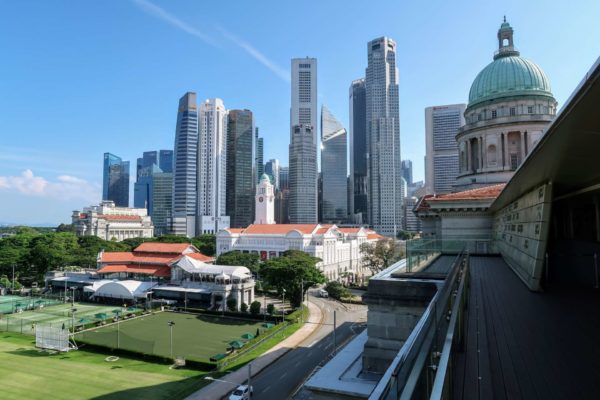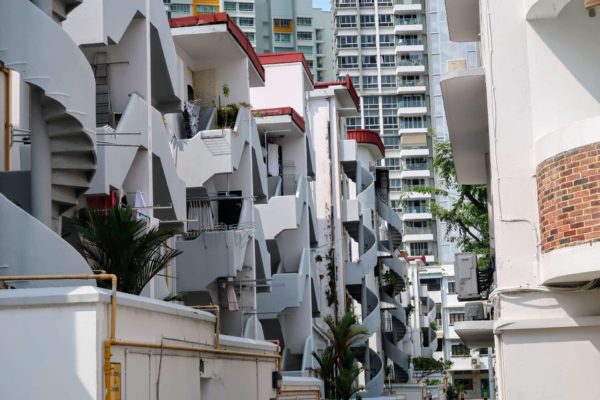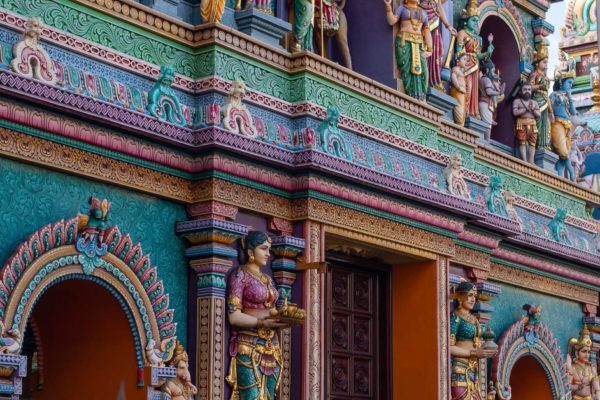By Vicky · Published Mar. 4th, 2022 · Updated Dec. 31st, 2023
When you buy through links highlighted with an asterisk (*) on this site, we may earn a small affiliate commission at no cost to you.
On this Chinatown walking trail admire beautiful temples, sample delicious food and find where old meets new in Singapore.
Page Contents:
How to get to Chinatown
Chinatown is to the west of the city centre. The best MRT station is Chinatown MRT, located on the edge of this district. Chinatown MRT is on both the Blue Downtown Line and Purple North-East Line. For the Chinatown Walking Trail, exit the MRT station via exit A. There are also many buses that stop nearby.
Chinatown Walking Trail Map
Get the route by downloading the .gpx or .kml file below. For navigation with Maps.me on your mobile phone, simply download the .kml file and open to add it to the Maps.me bookmarks.
Tips for Chinatown Walking Trail
- This walking trail is 6 km long but can easily be shortened to 3 km by cutting from Stop 3 to Stop 7.
- The two main sites, Buddha Tooth Relic Temple and Thian Hock Keng Temple, are open every day 9am-5pm and 7:30am-5:30pm respectively.
- Early mornings and late afternoons or evenings are good times to walk this trail as Chinatown can get hot and crowded in the middle of the day.
- If you enjoy this Chinatown walking trail, check out our Colonial District, Tiong Bahru, Little India or Kampong Glam Walking Trail.
Attractions on the Chinatown Walking Trail
On this walking trail through Chinatown, you’ll see the main sites and attractions of Chinatown:
- Chinatown Heritage Centre
- Chinatown Street Markets on Pagoda Street, Trengganu Street and Temple Street
- Buddha Tooth Relic Temple
- Keong Saik Road
- NUS Baba House
- Pinnacle@Duxton Skybridge
- Singapore City Gallery
- Telok Ayer Street
- Thian Hock Keng Temple
- Nagore Dargah Shrine
- Amoy Street
- Ang Siang Hill Park
- Ann Siang Road and Club Street
- Sri Mariamman Temple
- People’s Park Complex Viewpoint
This walking tour is self-guided. If you prefer to be accompanied and shown around, try a Guided Walking Tour of Chinatown*.
Food options on this walking tour include two hawker centres at Chinatown Complex Food Court and Maxwell Food Centre. You will also visit a bakery called Tong Heng Traditional Cantonese Pastries. Additionally, there are many restaurants and bars all over the area.
History of Chinatown
The area that now forms Chinatown was designated as a Chinese settlement by Sir Stamford Raffles in his Town Plan of 1822. The town was originally subdivided into areas for immigrants from specific parts of China, for example those from Canton settled around Temple Street while the Hokkien community centred Telok Ayer Street.
In the late 19th and early 20th centuries, Chinatown was crowded and sometimes dangerous. Opium dens were plentiful and you had to watch out after dark. Today it’s very different and you can marvel at the combination of old and modern. You can see a mix of cultures, with ornate temples next to trendy bars, and mosques next to churches next to temples.
Chinatown Walking Trail Route
This walking trail starts from Chinatown MRT station, Exit A. You will come up into Pagado Street, a pedestrianised street in the heart of Chinatown.
Directions: Walk about 50 metres down the road and the first stop is on your left.
1. Chinatown Heritage Centre
Key Information: Chinatown Heritage Centre is currently closed (2022).
The Chinatown Heritage Centre (Website, Tripadvisor Reviews*) is the place to learn more about Chinese Heritage and a great introduction to the area. You can equally well visit at the end of this walking trail to cool down in some air-conditioning.
The Centre takes up several restored shophouses and showcases how life has changed from when Chinatown was known for its trade, opium and crime in the late 1800s to the hipster, touristy district it has become today.
What are Shophouses?
Shophouses are a style of terraced house typical in Singapore. You’ll see a lot of shophouses around Chinatown. Many were bulldozed late last century to make way for high-rise tower blocks, but now their heritage is widely valued. You can find out more about them in the Singapore City Gallery later on the tour.
Directions: Turn right on Trengganu Street just opposite the Chinatown Heritage Centre.
2. Chinatown Street Markets
The outdoor Chinatown Street Markets are mainly on the intersecting Pagoda, Trengganu and Temple Streets, between Chinatown MRT and Buddha Tooth Relic Temple. Small market stalls line the streets, selling everything from souvenirs to antiques, and plants. There are also several cafes and restaurants amongst the shops. The streets come alive around mid-morning and it may be quiet first thing. It’s near the end of the tour so you can also return here later for some shopping.
Food & Activities in Chinatown
- Eat delicious Chinese food* near the Chinatown MRT stop
- Go on a Chinatown Food Tasting Tour*
- Have fun on the Chinatown Murders Game Tour*
Directions: After exploring the streets, walk down Tregganu Street and you will reach Telok Ayer Square.
Telok Ayer Square is just behind Buddha Tooth Relic Temple and is a gathering area for the locals. Chinese men can often be seen playing intense board games. On the right, in the colourful building that is the Chinatown Complex, is a hawker centre specializing in Chinese food. Surrounding the square is a hawker centre in the colourful building and Chinatown Visitor Centre or tourist information (open Mon-Sun: 10:00-19:00).
Directions: Walk around the temple to its entrance on the opposite side.
3. Buddha Tooth Relic Temple
Key Information: Open 9am-5pm every day and free to enter. You must dress respectfully, which means covered shoulders, no mini-skirts and no shorts. They do have some spare clothes in case you forget. Allow 30 minutes – 1 hour.
The Buddha Tooth Relic Temple (Website, Tripadvisor Reviews*) is a highlight of a walk through Chinatown. Though it looks old, it was actually built in 2007 at a cost of S$75 million. The temple’s name comes from the holiest relic it protects – one of Buddha’s teeth, specifically the left canine. It was supposedly taken from Buddha’s funeral pyre when he died roughly 2400 years ago.
Inside there are several large worship halls filled with buddha statues both large and small. Upstairs there is a little museum containing Buddhist artefacts and at the very top is the stupa (shrine) holding Buddha’s tooth. You have to take your shoes off at some point, but you don’t have to climb any stairs because there’s a lift inside the temple!
Buddha Tooth Relic Temple Viewpoint
Directions: If you don’t mind climbing stairs, head to the back left corner of the temple. Take the stairs at the side of the HDB and climb up for a great view.
From the HDB balcony you have splendid views over the temple, Chinatown, and the tall downtown buildings behind.
Directions: At the front of the temple head right along South Bridge Road and you’ll soon see a fancy building on the corner.
The old triangular building made of brick is Jinrikisha Station. Built in 1903, it was a public transport hub, not for buses or trains but for rickshaws. Its name, Jinrikisha, is a Japanese word meaning ‘human-powered carriage’. Did you know? – Jackie Chan owns this building!
Shortcut: Head straight from Jinrikisha Station to Stop 7 (Singapore City Gallery). This will make the Chinatown Walking Trail only 3 km long. The full trail is 6.5 km. To get there head down Maxwell Road, between Jinrikisha Station and Maxwell Food Court. Stop 7 is 100 metres further on.
Directions: To continue with the full tour, continue to walk along Neil Road. After 300 metres, turn right on Keong Saik Road.
4. Keong Saik Road
Keong Saik Road is a street full of hipster bars, restaurants and cafes. Quite a transformation from the 1950s when it was Chinatown’s red-light district and known colloquially as Mistress Avenue. Halfway down the street is an iconic red and white building, now home to Potato Head, a bar and dining concept with the highlight being a rooftop bar with city views. Additionally, there are two Michelin starred restaurants and humble Kopitiam (traditional coffee shop) eateries all intermingling with shophouses and temples.
To the left of a triangular road junction at the end of the street is Sri Layan Sithi Vinayagar Temple. It has a lovely, colourful gopura – the decorated entrance gate to the temple.
Directions: Immediately after the temple head left into Duxton Plain Park.
This park has a narrow, linear shape because it follows a disused railway line. You can’t see any signs of the railway apart from in the shape of the park. The MRT line actually still follows part of this curving park, but deep underground.
Directions: After roughly 100 metres head right down some steps and then left on Bukit Pasoh Road.
Bukit Pasoh Road
Bukit Pasoh Road has some lovely shophouses, cool bars and old clan associations. Basoh means ‘flower pot’ in Malay, and earthenware pottery for storing rice was made on this street. Look out for the Ee Hoe Hean Club (a white building from 1927), which was created as a club exclusively for millionaires.
Directions: At the end of the street turn right on Neil Road and across the large Cantonment Road. Continue along Neil Road.
A feature of interest along Neil Road is the grand Neoclassical building on the right, a former Methodist Girl’s School. It’s now some form of jobcentre.
Directions: Continue along Neil Road and soon you’ll see some ornate shophouses on the left. One of these is the next stop.
5. NUS Baba House
Key Information: Heritage Tours 10 am Tue-Fri, self-guided tours 1-4:30 pm on Saturdays. Must be booked far in advance. Free for locals, $10 for others.
Baba House (Website, Tripadvisor Reviews*) is a great place to explore Peranakan Culture (additionally, check out the Peranakan Museum on the Colonial District Walking Trail). It’s one of the only shophouses to have been preserved on the inside as well as the outside. Donated by the descendants of a rich Peranakan merchant, today the interior is gorgeously renovated. There’s a fantastic roofless and free-flowing courtyard in the main room that brings light into the entire house, and the furniture is unique and ornate.
Directions: From the Baba House, continue slightly further on the road and take the first left on a small street. At the first junction take a left again onto Everton Road.
This district is known as Everton Park, a residential neighbourhood that contains many shophouses. There are also some murals dotted around to watch out for. The streets are fairly quiet, and many residents have placed tables and chairs under their five-foot ways to sit outdoors and admire the street.
After the shophouses you’ll see the HDB estate called Everton Park. This is how most Singaporeans now live, a distinct change from the old to the new.
HDB Estates
HDB stands for Housing and Development Board. It’s a governmental organisation that builds towerblocks and sells or rents the flats at relatively low prices to the Singaporean population. They all look rather similar and uniform in style, with the unique exception of the Pinnacale@Duxton. The fancier towerblocks are almost all privately built and often referred to as ‘condos’. HDB construction has transformed the landscape of Singapore from idyllic jungle dotted with villages to a concrete jungle where air-conditioning comes as standard.
Directions: Head through Everton Park HDB complex and out the other side onto Cantonment Road. Cross over the road to the obvious towers of the next stop.
6. Pinnacle@Duxton Skybridge
Surprisingly, this fancy towerblock complex is also an HDB housing estate. You can visit the Skybridge (open 9am-9pm) here, from which there are great views. However, there is a quota of 200 people per day, so if you’re late on a weekend you might not be allowed up. You have to pay in cash ($6) and take your Metro EZlink card – they’ll swipe it and record that you have visited – you can only visit once.
Directions: Head through the Pinnacle Complex and you’ll come out on Duxton Plain Park by an eatery called Essen. Turn right and soon you’ll be on a main road. Head left.
Poo Thor Jee Temple, a colourful Buddhist Temple, is on the left-hand side. A statue of Laughing Buddha sits just outside.
Directions: Continue down the road and head slightly right and across to walk up Duxton Road. At the car park on top of the hill, head right down Duxton Hill street. Cross over the main road, turn right and then left up Cook Street. At the corner take the pedestrian lane to Maxwell Road.
Duxton Road and the surrounding streets are lined with shophouses, still used today as either shops or restaurants. When you arrive at Maxwell Road you’ll see Maxwell Food Centre opposite, another great hawker place for Chinese food.
Directions: To the right of Maxwell Food Centre is the next stop.
7. Singapore City Gallery
Key Information: Free to enter, open Monday to Saturday, 9 am to 5 pm. Closed Sundays and Public Holidays.
The Singapore City Gallery (Website, Tripadvisor Reviews*) is a museum about city planning. It focuses on Singapore’s transformation from the 1950s to the present, and also what the future might hold for the city-state.
One of the highlights is a large 3D map of the downtown area. It’s a great way to learn about the central geography of Singapore and spot your favourite landmarks.
Directions: After the Gallery, continue down the street until you reach a small park on the corner.
Telok Ayer Park has several benches for a little rest and nice greenery. Just opposite the gardens is a lovely church. Telok Ayer Chinese Methodist Church has been here for over a century. The architecture is an eclectic mix of European layout, Byzantine and Art Deco windows, with a Chinese roof structure.
Directions: This church is at the beginning of Telok Ayer Street, which continues to the left.
8. Telok Ayer Street
This street is lined with many old religious buildings on one side and modern skyscrapers on the other. Apart from the church, you’ll also see Al Abrar Mosque, Thian Hock Keng Temple and Nagore Dargah Shrine. Apart from the heritage buildings, you’ll also find some of the coolest bars in Chinatown in this area.
Directions: After passing the mosque you’ll soon reach Thian Hock Keng Temple, a highlight of the Chinatown Walking Trail.
9. Thian Hock Keng Temple
Key Information: Free to enter and open 07:30-17:30 every day. Dress respectfully.
Thian Hock Keng Temple (Tripadvisor Reviews*) is a definite must-visit in Chinatown. It’s the oldest Chinese temple in Singapore, from 1839. The temple structure is held together by cleverly designed interlocking wooden joints, no nails were used in its construction!
Telok Ayer Street used to be on the shoreline and at this temple, Mazu, the Goddess of the Sea, is worshipped. Chinese immigrants straight off the boats came here to give thanks for their safe passage. There are several smaller shrines dotted around the temple complex dedicated to Guanyin and Confuscious among others.
Explore Chinese Heritage in Chinatown
- Visit the Chinatown Heritage Centre on Pagoda Street
- Make sure to visit Buddha Tooth Relic and Thian Hock Keng Temple.
- Stroll the Chinatown street markets of Pagoda, Trengganu and Temple Street
- Try delicious Chinese food at the Chinatown Complex, Maxwell Food Court or Spring Court Restaurant*.
Directions: Up the street and almost next door to the temple is the next stop.
10. Nagore Dargah Shrine
Key Information: Free to enter, donations accepted. Open 10 am-12:30 pm and 2:30 pm-5 pm on weekdays, 9 am-1 pm on Saturdays. Dress respectfully.
Nagore Dargah Shrine (Tripadvisor Reviews*) is adjacent to Tian Hock Eng Temple. It’s actually a small-scale replica of a shrine in Tamil Nadu, on the east coast of southern India. The Indian Muslim Heritage Centre is inside. It contains lots of interesting information about this community along with some history of trading and Singapore. The building itself has a combination of styles – French windows, Greek columns, a mix of Eurasian and Berber arches, as well as some Malay influence.
Directions: Continue to the end of Telok Ayer Street past several restaurants. You’ll soon reach the busy Cross Street.
On the opposite side of the busy road you can see Ying Fo Fui Kun – an old Chinese Clan Association building. The tall, modern Clan Hotel next door is named after it.
Directions: Turn left and left again to walk back down Amoy Street.
11. Amoy Street
Like Telok Ayer Street, Amoy Street is full of hipster shops, bars, cafes and restaurants. Don’t miss the Thian Hock Keng Wall Mural on the back wall of the temple. It’s painted by Yip Yew Chong who has made several other murals that you can visit on our Tiong Bahru Walking Trail. The temple wall mural is a lovely depiction of street life in Singapore and how it has changed over the years.
At the end of Amoy Street is the little Siang Cho Keong Temple. The temple was built here because of its good location and Fengshui. It faced the ocean and had a hill behind it. Nowadays land reclamation projects mean the sea is much further away.
Directions: On the right-hand side of the temple is a wooden-roofed passageway heading to the next stop via a few steps.
12. Ann Siang Hill Park
Ann Siang Hill Park has some nice walkways and views of the tall downtown skyscrapers. It’s named after Chia Ann Siang, a Chinese Hokkien merchant who traded goods such as spices, tea, silk and coconuts between China and Europe. He went on to found his own timber company and became extremely rich. He bought the area now known as Ann Siang Hill in the late 1800s.
Rich Chinese and Peranakan Chinese used to live on the hill and it was a lively centre of trade and cultural activities. Clan associations and trade gilds were also located nearby. The exclusive Chinese Weekly Entertainment Club was founded in 1889 and still exists next to the park today.
Directions: Take the path around by the cafe which leads to Ann Siang Hill passageway. Continue down the hill until the road junction.
13. Ann Siang Road and Club Street
Ann Siang Road and Club Street are great for nighttime hangout spots. It can get busy, but on the weekends (Friday and Saturday) it’s nice when the roads are closed to traffic and filled with tables and people instead. Don’t miss the cool rooftop bars here.
Directions: Walk down the hill on Ann Siang Hill Road and you’ll soon reach busy South Bridge Road.
If you’re feeling peckish, there’s a great bakery on your left at the corner called Tong Heng Traditional Cantonese Pastries.
Directions: Head right along South Bridge Road and you’ll soon see the colourful temple that is the next stop.
14. Sri Mariamman Temple
Key Information: Free to enter, small fee for cameras. Open every day 5 am–11.30 am and 5 pm–8.45 pm. Dress respectfully. You must take off your shoes before entering.
Sri Mariamman Temple (Website, Tripadvisor Reviews*) is famous for fire-walking (Thimithi), which occurs a week before Divali (Oct-Nov). Hindu devotees walk across hot coals to receive a blessing from Draupadi, a popular goddess in Tamil Nadu. Apparently if you walk in a fast but calm manner, it doesn’t hurt too much.
Sri Mariamman is a folk goddess who helps cure illnesses. The temple itself is built in a southern Indian style, with a striking gopuram over the main entrance. It’s from 1827 and is the oldest Hindu Temple in Singapore, having been restored several times.
Directions: Head right at the temple.
Jamae Mosque (Website, Tripadvisor Reviews*) is almost next door to the Hindu Temple. It’s open 7:30 am to 5 pm and you’re welcome to visit, but dress respectfully.
Directions: Walk up the street just to the right of the mosque, appropriately named Mosque Street. A the end of the street you’ll reach a busy double road. If you want to head to a viewpoint over Chinatown, cross the road via the pedestrian bridge to the left.
15. People’s Park Complex Viewpoint
The pedestrian bridge leads into People’s Park Complex mall. To get to the photo spot you’ll need to head for the roof. To get there, head up as far as possible inside the mall and then out into an attached multistory car park. Head up another floor and you’ll come out on the roof. Head to the other side of the yellow apartment block and to the front of the roof. From here you can see over the roofs of Chinatown and to the Financial District beyond.
Directions: This is the end of the walking tour. To return to Chinatown MRT, cross back over the pedestrian bridge and you’ll be right at an entrance.
Chinatown Walking Trail by Night
Chinatown is an interesting, lively place to visit on weekend evenings. There are trendy bars and restaurants, rooftop terraces, and some streets are closed to traffic to allow tables and people instead. While many museums are closed, the ambience is nice and it tends to be less busy with cars. During Chinese New Year (around February) many lanterns and street lights make it an extra worthwhile excursion.
If you enjoyed this trail, why not check out our other neighbourhood trails: the Kampong Glam Walking Trail, the Little India Walking Trail, or the nearby Tiong Bahru Walking Trail. For more walking guides and hikes, check out our Singapore Hiking Guide.
FAQS – Chinatown Walking Trail
Chinatown is known for its mix of old and new. Chinatown contains several culturally important temples and religious buildings of many different faiths. It’s also known for delicious food, hipster bars and many shops.
The top sights of Chinatown are the Buddha Tooth Relic Temple and the Thian Hock Keng Temple.
To get to Chinatown, take the MRT to Chinatown MRT station on the blue Downtown and purple North-East line. There are also many buses that stop just next to Chinatown MRT.

